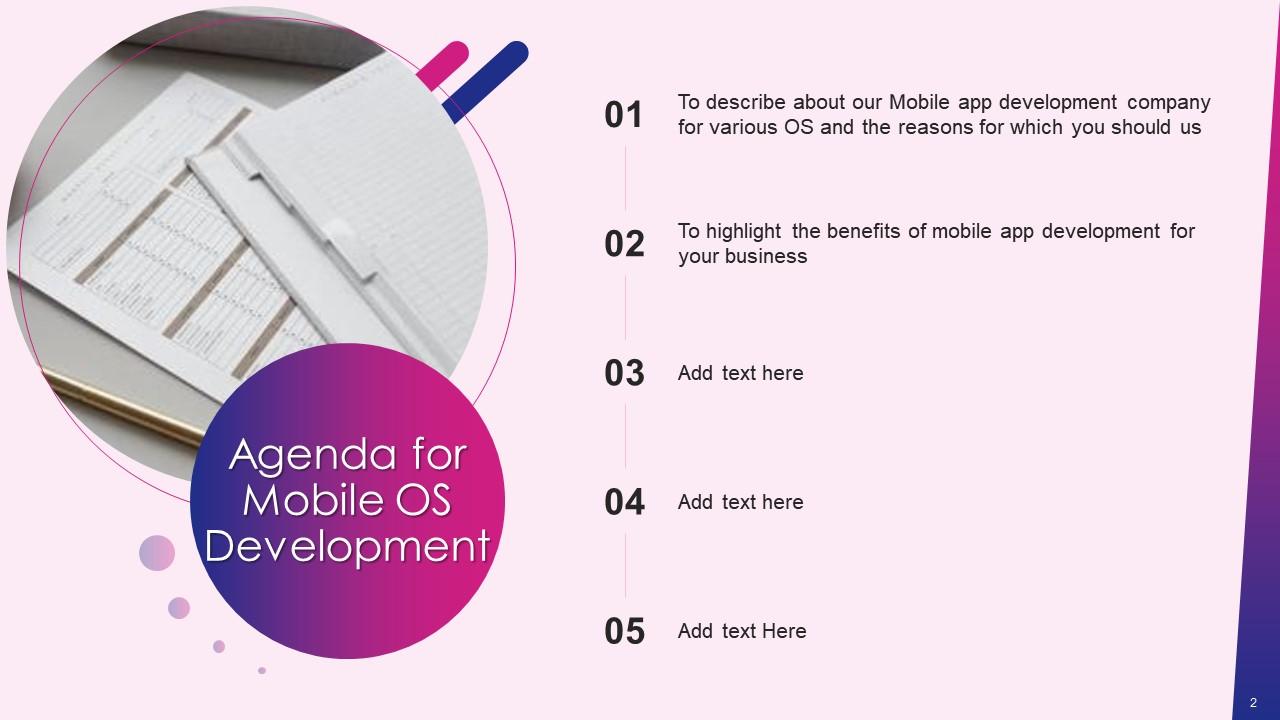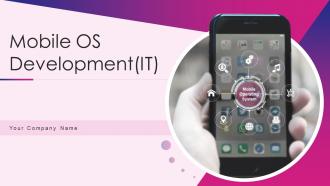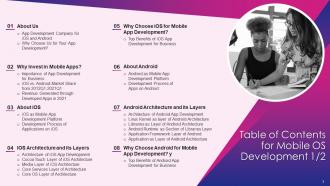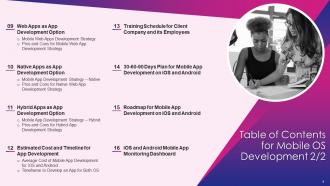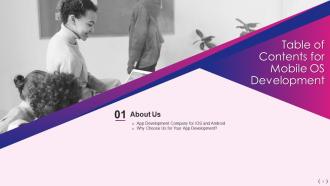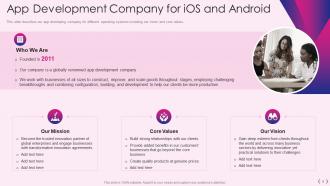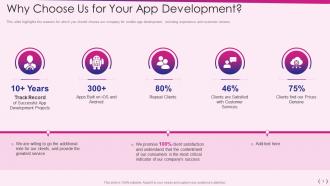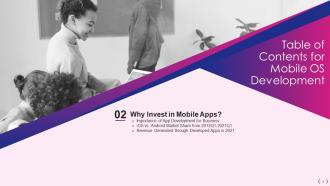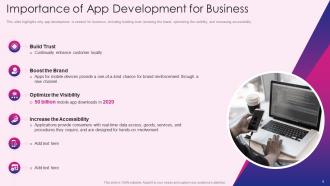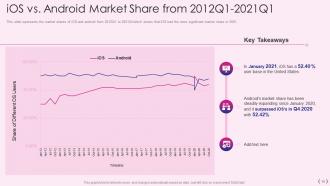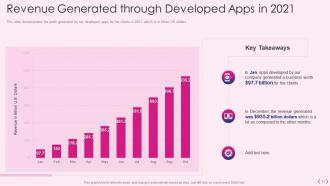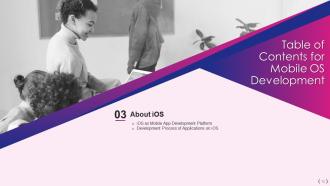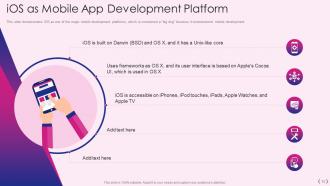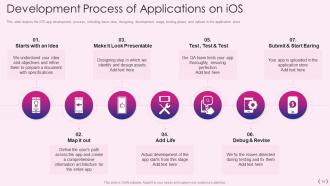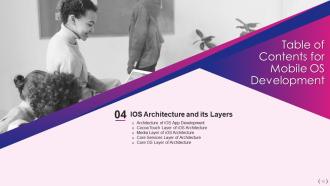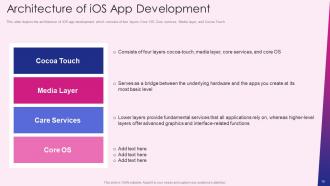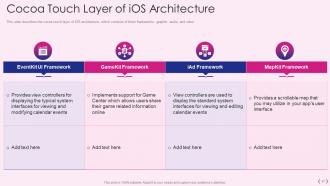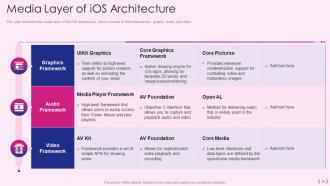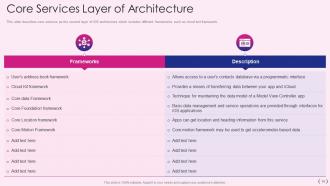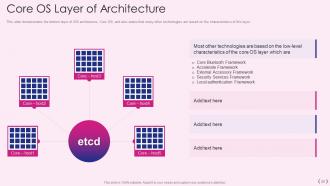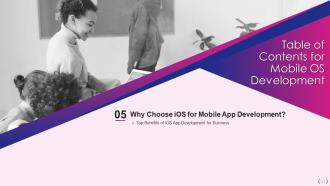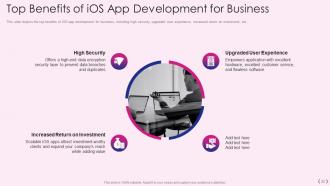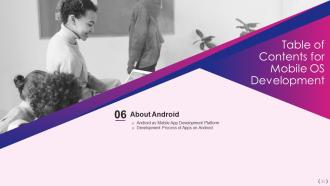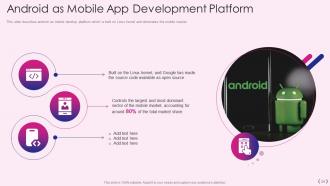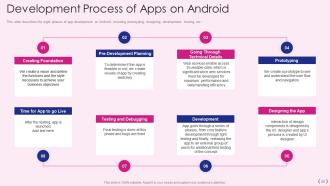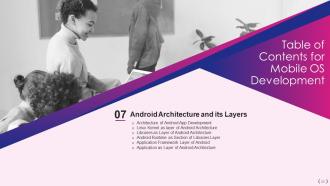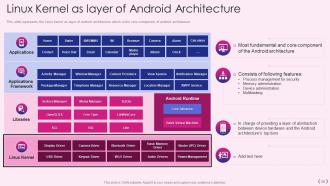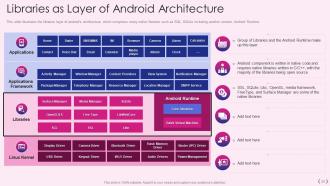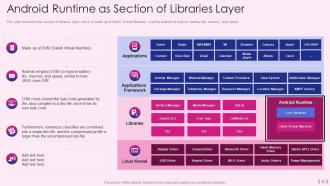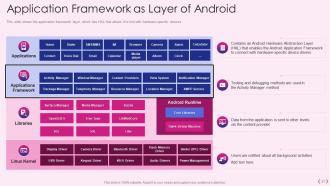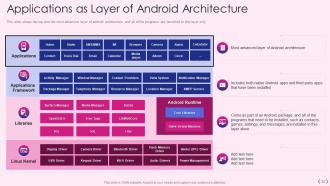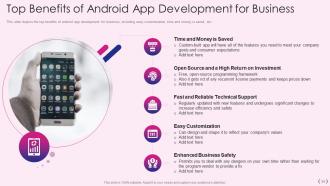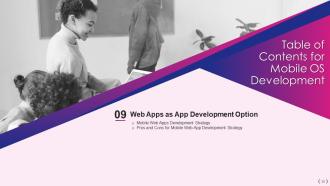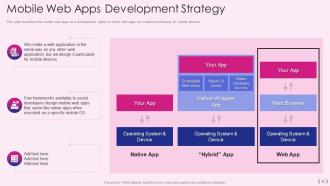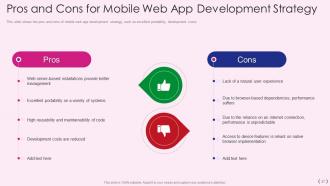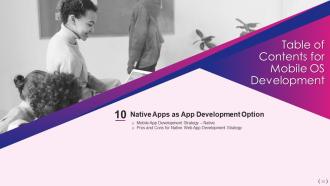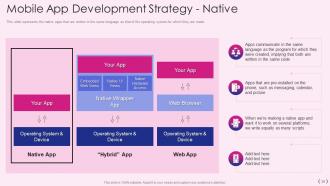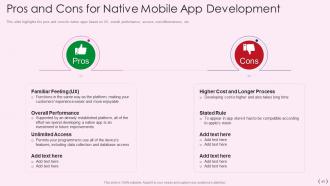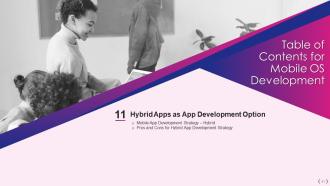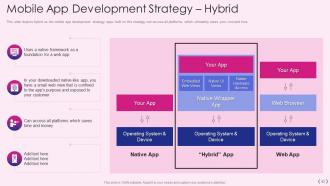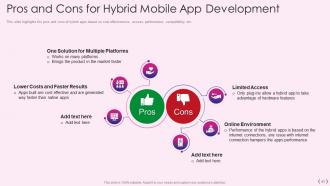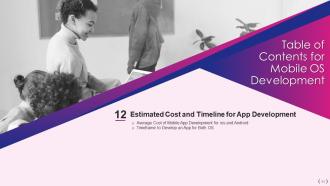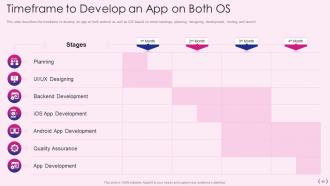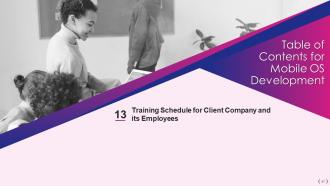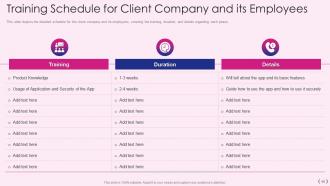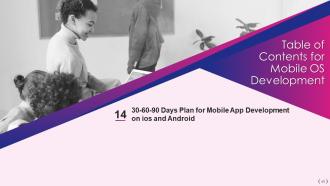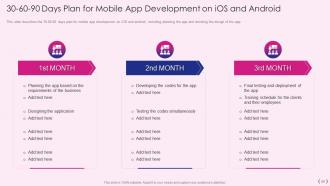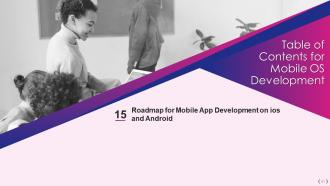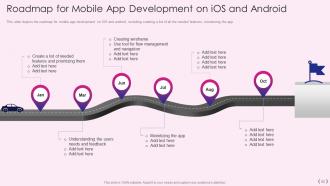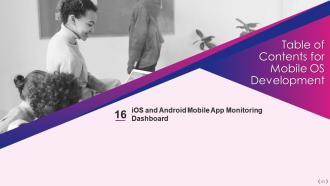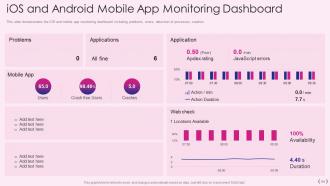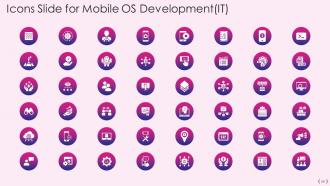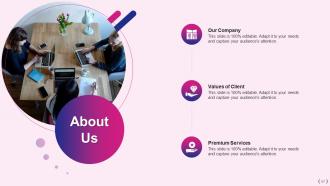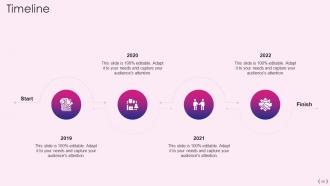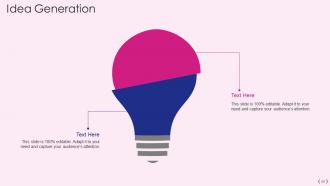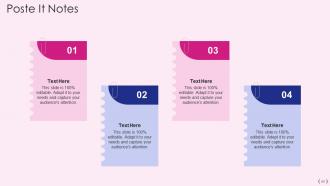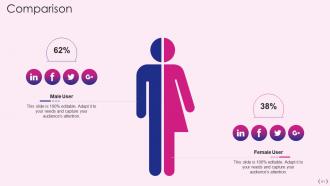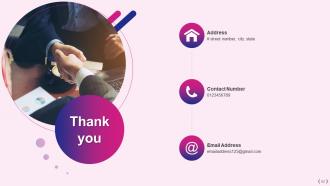Mobile os development it powerpoint presentation slides
A mobile operating system is a software framework that allows other applications, known as an application program, to operate. Here is a professionally designed Mobile OS Development IT that provides an overview of the mobile app development firm that makes apps for different operating systems, its mission, successful projects, and its vision. This OS Development PowerPoint presentation covers the reasons to invest in mobile apps, their market share, and revenue. Additionally, this App Development PPT introduces iOS, its architecture, and the benefits of iOS app development for business. Furthermore, this template includes a detailed overview of android, including the development process of apps on android, its architecture, and the benefits of android apps. Also, this iOS Apps PPT covers the mobile app development strategy that includes web apps, native apps, and hybrid apps, along with its pros and cons, respectively. This Mobile OS PowerPoint also caters to the estimated budget and timeframe to develop an app for both operating systems. Lastly, this Mobile Development deck comprises a 30-60-90 days plan, a roadmap, and a dashboard for iOS and Android mobile app monitoring. Get access now.
You must be logged in to download this presentation.
PowerPoint presentation slides
This complete presentation has PPT slides on wide range of topics highlighting the core areas of your business needs. It has professionally designed templates with relevant visuals and subject driven content. This presentation deck has total of sixty two slides. Get access to the customizable templates. Our designers have created editable templates for your convenience. You can edit the color, text and font size as per your need. You can add or delete the content if required. You are just a click to away to have this ready-made presentation. Click the download button now.
People who downloaded this PowerPoint presentation also viewed the following :
Content of this Powerpoint Presentation
Slide 1: This slide introduces Mobile OS Development(IT). State Your Company Name and begin.
Slide 2: This slide shows Agenda for Mobile OS Development.
Slide 3: This slide presents Table of Contents for Mobile OS Development.
Slide 4: This is another slide continuing Table of Contents for Mobile OS Development.
Slide 5: This slide shows title for topics that are to be covered next in the template.
Slide 6: This slide describes our app developing company for different operating systems.
Slide 7: This slide highlights the reasons for which you should choose our company for mobile app development.
Slide 8: This slide shows title for topics that are to be covered next in the template.
Slide 9: This slide highlights why app development is needed for business, including building trust, boosting the brand, etc.
Slide 10: This slide represents the market shares of iOS and android from 2012Q1 to 2021Q1.
Slide 11: This slide demonstrates the profit generated by our developed apps for the clients in 2021.
Slide 12: This slide shows title for topics that are to be covered next in the template.
Slide 13: This slide demonstrates iOS as one of the major mobile development platforms.
Slide 14: This slide depicts the iOS app development process, including basic idea, designing, development stage, etc.
Slide 15: This slide shows title for topics that are to be covered next in the template.
Slide 16: This slide depicts the architecture of iOS app development which consists of four layers.
Slide 17: This slide describes the cocoa touch layer of iOS architecture, which consists of three frameworks.
Slide 18: This slide represents the media layer of the iOS architecture.
Slide 19: This slide describes core services as the second layer of iOS architecture which includes different frameworks.
Slide 20: This slide demonstrates the bottom layer of iOS architecture i.e. Core OS.
Slide 21: This slide shows title for topics that are to be covered next in the template.
Slide 22: This slide depicts the top benefits of iOS app development for business, including high security, upgraded user experience, etc.
Slide 23: This slide shows title for topics that are to be covered next in the template.
Slide 24: This slide represents Android as Mobile App Development Platform.
Slide 25: This slide describes the eight phases of app development on Android, including prototyping, designing, development, etc.
Slide 26: This slide shows title for topics that are to be covered next in the template.
Slide 27: This slide depicts the architecture of android development, including a stack of software components.
Slide 28: This slide showcases Linux Kernel as layer of Android Architecture.
Slide 29: This slide illustrates the libraries layer of android's architecture, which comprises many native libraries.
Slide 30: This slide describes the section of libraries layer, which is made up of Dalvik Virtual Machine.
Slide 31: This slide shows the application framework layer, which has HAL that allows it to link with hardware-specific devices.
Slide 32: This slide presents Applications as Layer of Android Architecture.
Slide 33: This slide shows title for topics that are to be covered next in the template.
Slide 34: This slide displays Top Benefits of Android App Development for Business.
Slide 35: This slide shows title for topics that are to be covered next in the template.
Slide 36: This slide describes the mobile web apps as a development option in which web apps are created particularly for mobile devices.
Slide 37: This slide showcases Pros and Cons for Mobile Web App Development Strategy.
Slide 38: This slide shows title for topics that are to be covered next in the template.
Slide 39: This slide represents the native apps that are written in the same language as that of the operating system.
Slide 40: This slide showcases Pros and Cons for Native Mobile App Development.
Slide 41: This slide presents Table of Content for the presentation.
Slide 42: This slide depicts hybrid as the mobile app development strategy with access to all platforms.
Slide 43: This slide showcases Pros and Cons for Hybrid Mobile App Development.
Slide 44: This slide shows title for topics that are to be covered next in the template.
Slide 45: This slide represents Average Cost of App Development for iOS and Android.
Slide 46: This slide describes the timeframe to develop an app on both android as well as iOS.
Slide 47: This slide shows title for topics that are to be covered next in the template.
Slide 48: This slide showcases Training Schedule for Client Company and its Employees.
Slide 49: This slide shows title for topics that are to be covered next in the template.
Slide 50: This slide presents 30-60-90 Days Plan for Mobile App Development on iOS and Android.
Slide 51: This slide shows title for topics that are to be covered next in the template.
Slide 52: This slide displays Roadmap for Mobile App Development on iOS and Android.
Slide 53: This slide shows title for topics that are to be covered next in the template.
Slide 54: This slide demonstrates the iOS and mobile app monitoring dashboard.
Slide 55: This slide is titled as Additional Slides for moving forward.
Slide 56: This slide displays Icons for Mobile OS Development(IT).
Slide 57: This is About Us slide to show company specifications etc.
Slide 58: This is a Timeline slide. Show data related to time intervals here.
Slide 59: This is an Idea Generation slide to state a new idea or highlight information, specifications etc.
Slide 60: This slide shows Post It Notes. Post your important notes here.
Slide 61: This is a Comparison slide to state comparison between commodities, entities etc.
Slide 62: This is a Thank You slide with address, contact numbers and email address.
Mobile os development it powerpoint presentation slides with all 67 slides:
Use our Mobile OS Development IT Powerpoint Presentation Slides to effectively help you save your valuable time. They are readymade to fit into any presentation structure.
FAQs
The iOS app development process consists of several key stages, such as ideation, designing, development, testing, and deployment. During the ideation stage, the basic idea for the app is conceptualized. In the designing stage, the user interface and user experience design are created. The development stage involves the actual coding of the app. Testing ensures that the app is functioning as expected. Finally, deployment involves launching the app on the App Store.
The iOS architecture consists of four layers: Cocoa Touch layer, Media layer, Core Services layer, and Core OS layer. Each layer has its own set of functionalities and frameworks.
The Cocoa Touch layer is one of the layers of iOS architecture that deals with user interface and user experience design. It consists of three frameworks: UIKit, Foundation, and Core Animation.
The eight phases of app development on Android include ideation, market research, wireframing and prototyping, design, development, testing, deployment, and maintenance.
Android architecture consists of four layers: Linux kernel, libraries, application framework, and applications. Each layer provides specific functionalities and features that are necessary for building Android apps.
-
Excellent work done on template design and graphics.



